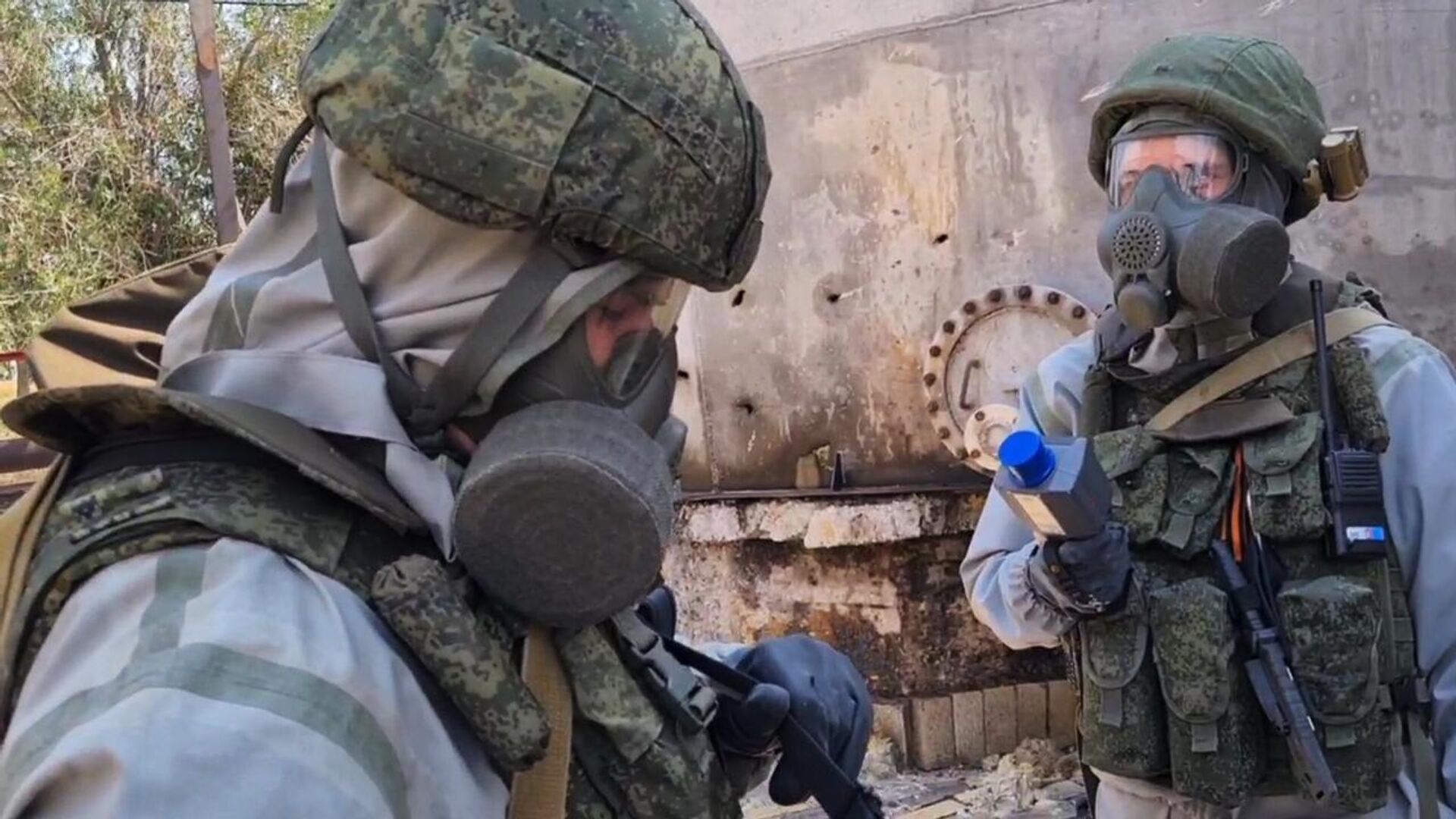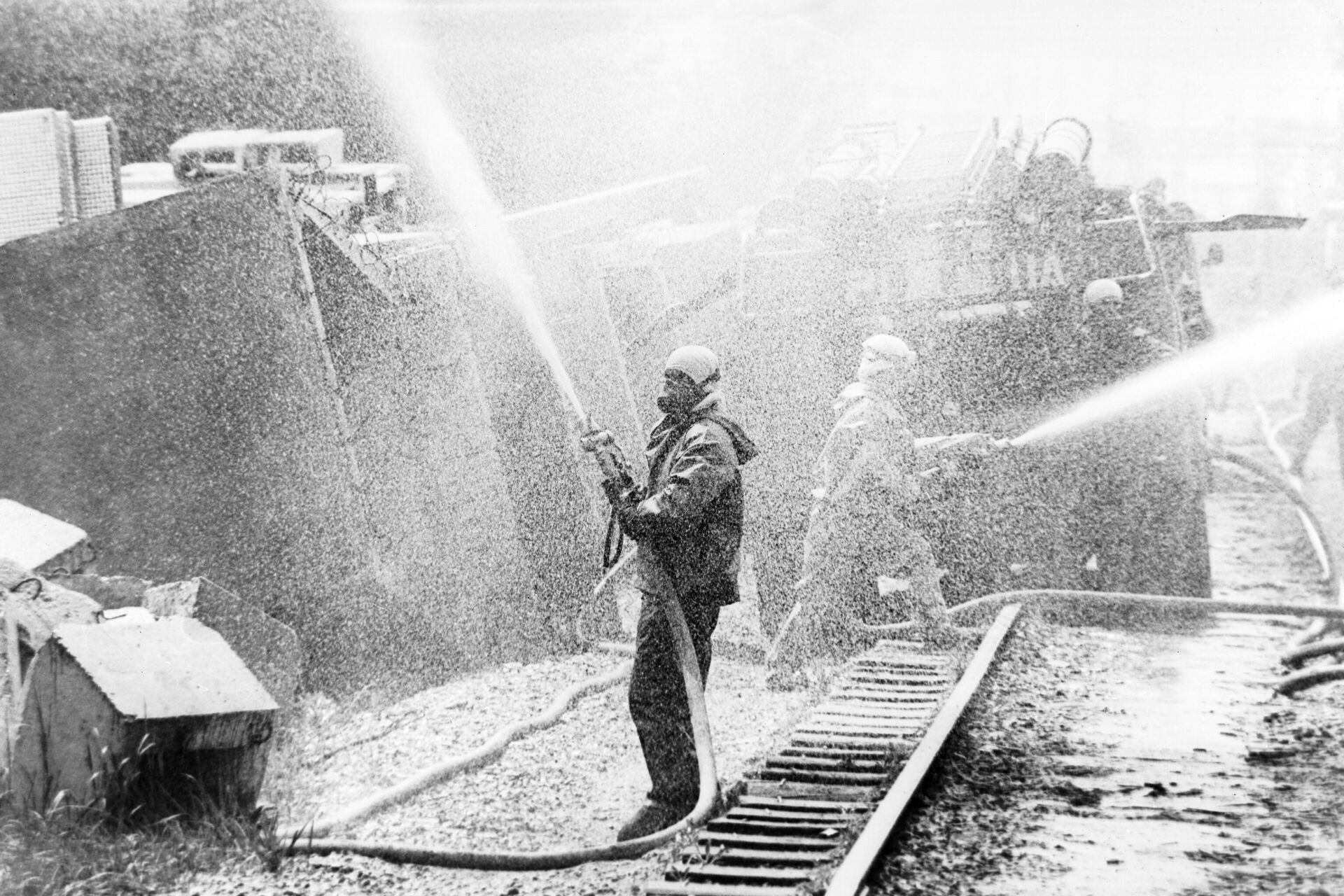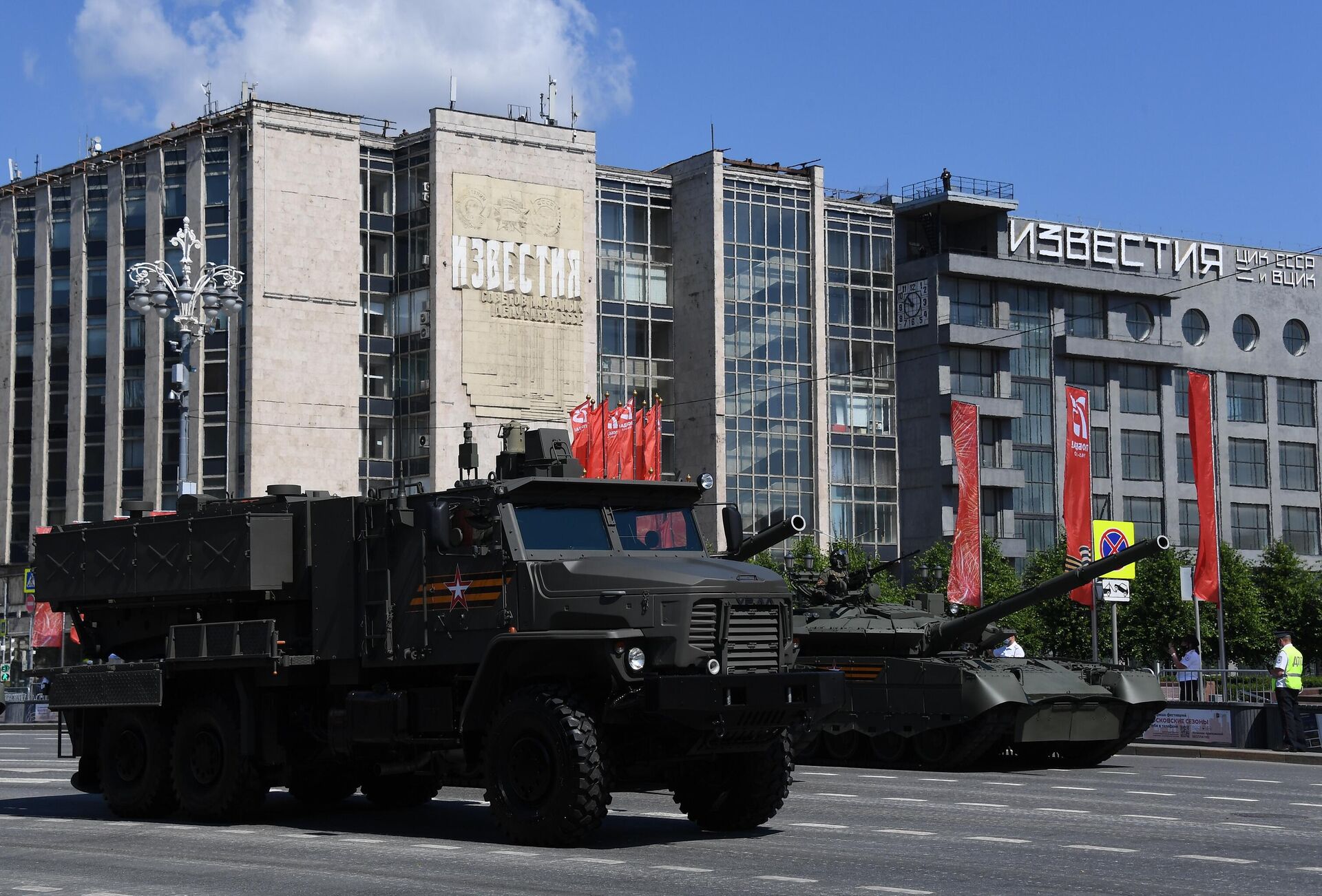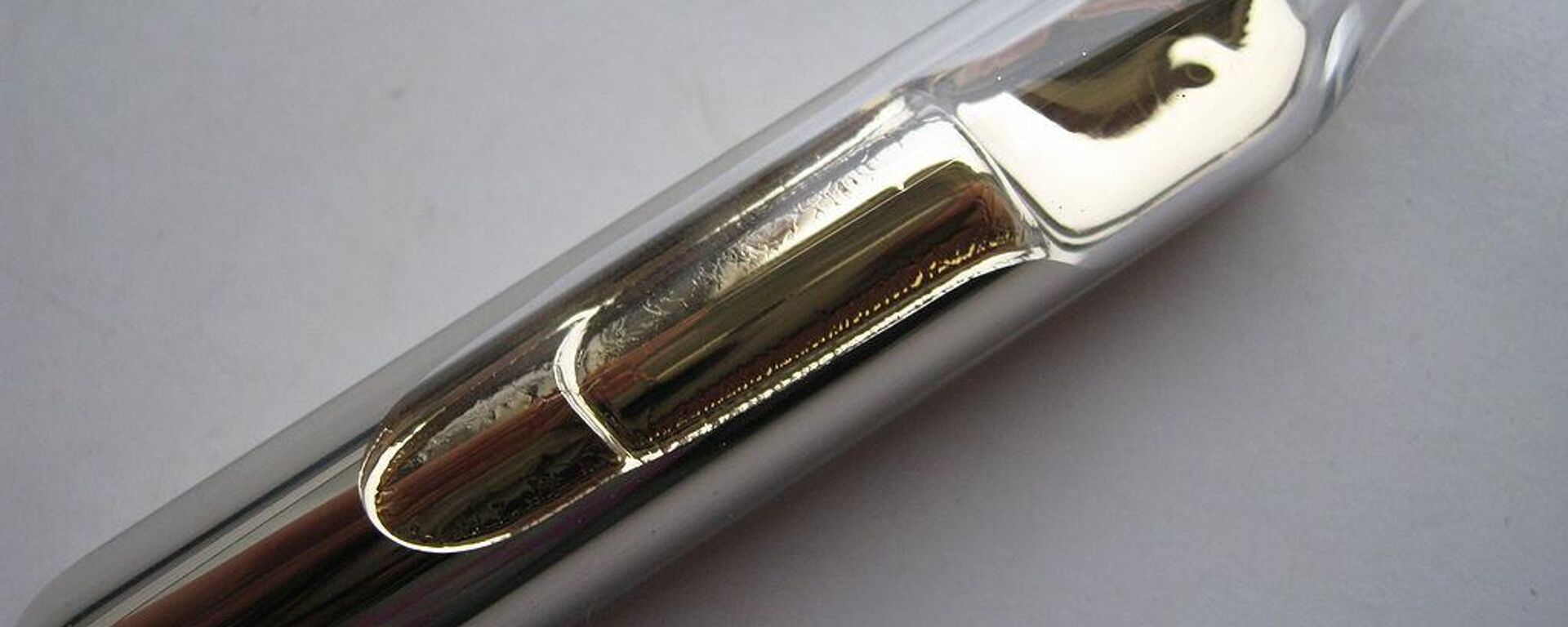https://sputnikglobe.com/20231113/untold-heroism-of-russias-radiological-chemical-and-biological-defense-troops-1114908415.html
Little-Known Facts About Russia’s Radiological, Chemical and Biological Defense Troops
Little-Known Facts About Russia’s Radiological, Chemical and Biological Defense Troops
Sputnik International
Russia’s Radiological, Chemical and Biological Defense Troops gained international attention and recognition in the spring of 2022, when they started uncovering trove after trove of classified documents detailing the extent of the US’s military biological programs in Ukraine and across the globe. Monday is their professional holiday.
2023-11-13T05:00+0000
2023-11-13T05:00+0000
2023-11-13T11:19+0000
military & intelligence
russia
ussr
red army
organization for the prohibition of chemical weapons (opcw)
russian armed forces
chernobyl
wwi
chemical weapons convention
ukraine
https://cdn1.img.sputnikglobe.com/img/07e7/0b/0c/1114908255_0:0:1280:720_1920x0_80_0_0_9cdd18b8c81b8dc461e877eb7f3a11ec.jpg
On November 13, 1918, the Revolutionary Military Council of the fledgling Soviet Russian Republic ordered the creation of the Chemical Troops of the Red Army of Workers and Peasants.The decision to establish the specialized force was taken in the immediate aftermath of World War I, which saw Imperial Germany liberally use chemical weapons against Russian forces on the Eastern Front.Through the 1920s and 1930s, the Chemical Troops prepared for the next great global conflagration, anticipating the widespread use of chemical weapons, training both troops and civilians in chemical defense, while stocking up on chemical weapons. The specialized units were eventually attached to all rifle and cavalry divisions and brigades.During the Second World War, fearing that Germany would repeat its WWI-era practice of using chemical weapons, the Red Army maintained forces and equipment to protect against and respond in kind to such attacks, creating 19 specialized chemical weapons brigades by 1944. Fortunately, the weapons were never used, and the most of these units were disbanded after the war.But the Cold War weapons of mass destruction arms race between the USA and the Soviet Union brought new importance to the Chemical Troops, whose responsibilities grew to include working with and defending against various other weapons of mass destruction, including biological, bacteriological and nuclear, and operating flamethrower-equipped ground forces.The Chemical Troops played a major role in dealing with the aftermath of the Chernobyl nuclear disaster in the spring and summer of 1986, with 10 regiments and battalions involved in cleanup operations, and the construction of the massive sarcophagus covering the building’s damaged Reactor Number 4. Chemical Troops chief Vladimir Karpovich Pikalov, who personally remained in the disaster zone for two straight months and received a severe dose of radiation, earned the title of Hero of the Soviet Union for his work. Ultimately, hundreds of troops at Chernobyl were exposed to dangerous levels of radiation while dealing with the consequences of an unprecedented technogenic catastrophe that no one has ever faced before, with dozens falling sick and dying prematurely in the years and decades following their exposure to ensure the safety of their motherland. In 1992, shortly after the collapse of the USSR, the Chemical Troops were renamed to their current name - the Radiological, Chemical and Biological Defense Troops. Their duties today remain mostly the same as before, including reconnaissance to detect heightened levels of radiation and the use of biological weapons, decontamination, degassing, disinfection and disinfestation of uniforms and equipment of forces operating in areas contaminated by WMDs.RCBD Troops include combat-ready formations, units and subunits sprinkled across military districts, formations and branches of the Russian Armed Forces, and man military scientific and training centers, where hundreds of grunts receive training in radiological, chemical and biological defense on a daily basis.Modern RCBD formations include nuclear-biological-chemical reconnaissance, protection, aerosol countermeasures, processing, equipment repair, and analysis centers, as well as units operating flamethrowers (like the deadly TOS-1A Solntsepek and TOS-2 Tosochka thermobaric warhead rocket launchers). For their service in Ukraine, Russia’s RCBD Troops have received a number of commendations, with two brigades bestowed the prestigious title ‘Guards,’ four officers getting Hero of the Russian Federation medals, and 310 troops receiving Order of Courage medals (four of them twice).“The success of our troops depends on the RCBD Troops’ professionalism and heroism,” Vasily Dandykin, a veteran military analyst and Russian Navy Captain 1st Rank (ret.) told Sputnik. “The enemy senses this and hunts for” RCBD Troops' operated flamethrowers. “Many fighters, dozens, hundreds have been awarded orders and medals, including the title of Hero of Russia,” Dandykin said.RCBD Troops have also proven their propensity to help Russia prevent conflicts, Dandykin pointed out, recalling their dispatch to Syria in 2013 to remove and dismantle the country’s stocks of chemical weapons to disarm the risk of a US invasion after a rebel false flag chemical attack.But it has been in the context of the Ukrainian crisis that the RCBD Troops have gained their highest level of international attention and renown, spending week after week and month after month in 2022 reporting on the vast network of military-biological labs funded and operated by the United States in Ukraine, across the former Soviet space, and around the world. The RCBD Troops reported on US-led work creating a dizzying variety of pathogens, including hemorrhagic diseases, leptospirosis, meningitis, hantaviruses, and work with serum samples specifically targeting populations of “Slavic ethnicity.”Not asking the international community to take their word for it, RCBD Troops' commanders accompanied their press releases with digital scans of some of the literally tens of thousands of documents seized from biolabs in Ukraine and found online.US officials and media initially dismissed the biolabs reporting as 'Russian propaganda', but ultimately went silent on the matter after Undersecretary of State Victoria Nuland confirmed the labs’ existence and their danger, and after a small number of foreign outlets also began reporting on the information, corroborating RCBD Troops’ findings.“We know that the Americans have created a large number of laboratories, including in Ukraine, where strains of viruses were made on the basis of genetic materials of Ukrainian military personnel,” Dandykin recalled. “This is also the concern of the RCBD Troops, and their chief speaks about it regularly, reports on the sad and tragic consequences these weapons can have on the civilian population, reports on what the Americans are doing in this direction, their work on viruses, etc.”In addition to their work uncovering US activities at Ukraine’s biolabs, Russia’s the RCBD Troops have served on the ground at the Chernobyl and Zaporozhye Nuclear Power Plants, and monitored out for enemy provocations, including those involving the use of dirty bomb weapons.
https://sputnikglobe.com/20230201/truth-too-big-to-hide-how-washington-fails-to-sweep-ukraines-biolab-revelation-under-rug-1106893548.html
https://sputnikglobe.com/20230623/perfect-ingredient-for-dirty-bomb-what-is-ceasium-137-1111424256.html
russia
ussr
ukraine
Sputnik International
feedback@sputniknews.com
+74956456601
MIA „Rosiya Segodnya“
2023
News
en_EN
Sputnik International
feedback@sputniknews.com
+74956456601
MIA „Rosiya Segodnya“
Sputnik International
feedback@sputniknews.com
+74956456601
MIA „Rosiya Segodnya“
russia, radiological, chemical and biological defense troops, radiation, chemical weapons, biological weapons, nuclear weapons, professional holiday, troops, forces, history, formation, creation
russia, radiological, chemical and biological defense troops, radiation, chemical weapons, biological weapons, nuclear weapons, professional holiday, troops, forces, history, formation, creation
Little-Known Facts About Russia’s Radiological, Chemical and Biological Defense Troops
05:00 GMT 13.11.2023 (Updated: 11:19 GMT 13.11.2023) Russia’s Radiological, Chemical and Biological Defense Troops first gained international attention and recognition in the spring of 2022, when they started uncovering trove after trove of classified documents detailing the extent of the US’s military biological programs in Ukraine and across the globe. Monday is their professional holiday.
On November 13, 1918, the Revolutionary Military Council of the fledgling Soviet Russian Republic ordered the creation of the Chemical Troops of the Red Army of Workers and Peasants.
The decision to establish the specialized force was taken in the immediate aftermath of World War I, which saw Imperial Germany liberally use chemical weapons against Russian forces on the Eastern Front.
Through the 1920s and 1930s, the Chemical Troops
prepared for the next great global conflagration, anticipating the widespread use of chemical weapons, training both troops and civilians in chemical defense, while stocking up on chemical weapons. The specialized units were eventually attached to all rifle and cavalry divisions and brigades.
During the Second World War, fearing that Germany would repeat its WWI-era practice of using chemical weapons, the Red Army maintained forces and equipment to protect against and respond in kind to such attacks, creating 19 specialized chemical weapons brigades by 1944. Fortunately, the weapons were never used, and the most of these units were disbanded after the war.
But the Cold War weapons of mass destruction arms race between the USA and the Soviet Union brought new importance to the Chemical Troops, whose responsibilities grew to include working with and defending against various other weapons of mass destruction, including biological, bacteriological and nuclear, and operating flamethrower-equipped ground forces.
The Chemical Troops played a major role in dealing with the aftermath of the Chernobyl nuclear disaster in the spring and summer of 1986, with 10 regiments and battalions involved in cleanup operations, and the construction of the massive sarcophagus covering the building’s damaged Reactor Number 4. Chemical Troops chief Vladimir Karpovich Pikalov, who personally remained in the disaster zone for two straight months and received a severe dose of radiation, earned the title of Hero of the Soviet Union for his work. Ultimately, hundreds of troops at Chernobyl were exposed to dangerous levels of radiation while dealing with the consequences of an unprecedented technogenic catastrophe that no one has ever faced before, with dozens falling sick and dying prematurely in the years and decades following their exposure to ensure the safety of their motherland.
In 1992, shortly after the collapse of the USSR, the Chemical Troops were renamed to their current name - the Radiological, Chemical and Biological Defense Troops. Their duties today remain mostly the same as before, including reconnaissance to detect heightened levels of radiation and the use of biological weapons, decontamination, degassing, disinfection and disinfestation of uniforms and equipment of forces operating in areas contaminated by WMDs.
RCBD Troops include combat-ready formations, units and subunits sprinkled across military districts, formations and branches of the Russian Armed Forces, and man military scientific and training centers, where hundreds of grunts receive training in radiological, chemical and biological defense on a daily basis.
Modern RCBD formations include nuclear-biological-chemical reconnaissance, protection, aerosol countermeasures, processing, equipment repair, and analysis centers, as well as units operating flamethrowers (like the deadly TOS-1A Solntsepek and TOS-2 Tosochka thermobaric warhead rocket launchers). For their service in Ukraine, Russia’s RCBD Troops have received a number of commendations, with two brigades bestowed the prestigious title ‘Guards,’ four officers getting Hero of the Russian Federation medals, and 310 troops receiving Order of Courage medals (four of them twice).
“The success of our troops depends on the RCBD Troops’ professionalism and heroism,” Vasily Dandykin, a veteran military analyst and Russian Navy Captain 1st Rank (ret.) told Sputnik. “The enemy senses this and hunts for” RCBD Troops' operated flamethrowers. “Many fighters, dozens, hundreds have been awarded orders and medals, including the title of Hero of Russia,” Dandykin said.
“We have these units not only in the Ground Forces, but across the military, including aviation and the Missile Forces. They also exist within the part of the Navy related to nuclear submarines,” the naval officer stressed, pointing to the RCBD Troops duties’ monitoring radiation levels, and standing ready to liquidate the consequences of accidents aboard nuclear missile subs.
RCBD Troops have also proven their propensity to help Russia prevent conflicts, Dandykin pointed out, recalling their dispatch to Syria in 2013 to remove and dismantle the country’s stocks of chemical weapons to disarm the risk of a US invasion after a rebel false flag chemical attack.
But it has been in the context of the Ukrainian crisis that the RCBD Troops have gained their highest level of international attention and renown, spending week after week and month after month in 2022 reporting on the vast network of military-biological labs funded and operated by the United States in Ukraine, across the former Soviet space, and around the world. The RCBD Troops
reported on US-led work creating a dizzying variety of pathogens, including hemorrhagic diseases, leptospirosis, meningitis, hantaviruses, and work with serum samples specifically targeting populations of “Slavic ethnicity.”
Not asking the international community to take their word for it, RCBD Troops' commanders accompanied their press releases with digital
scans of some of the
literally tens of thousands of documents seized from biolabs in Ukraine and found online.
US officials and media initially dismissed the biolabs reporting as 'Russian propaganda', but ultimately went silent on the matter after Undersecretary of State Victoria Nuland
confirmed the labs’ existence and their danger, and after a small number of foreign outlets also
began reporting on the information, corroborating RCBD Troops’ findings.
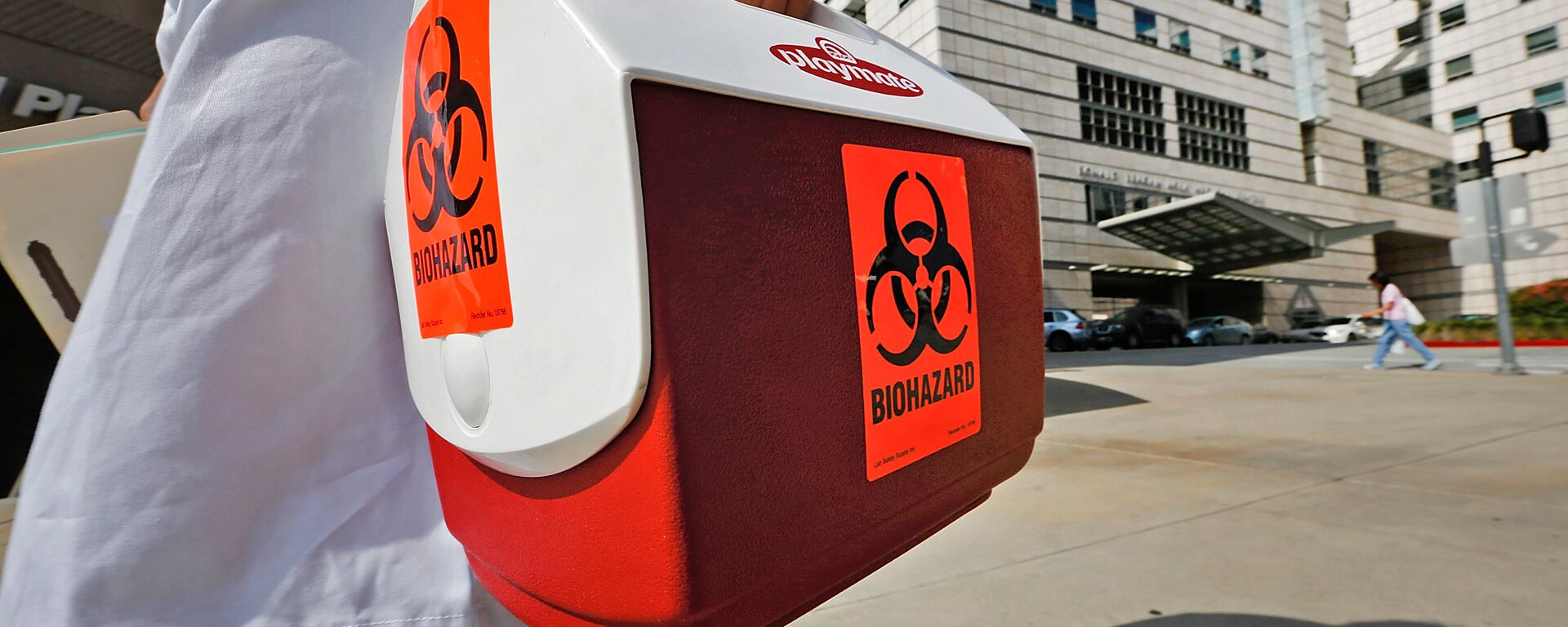
1 February 2023, 16:46 GMT
“We know that the Americans have created a large number of laboratories, including in Ukraine, where strains of viruses were made on the basis of genetic materials of Ukrainian military personnel,” Dandykin recalled. “This is also the concern of the RCBD Troops, and their chief speaks about it regularly, reports on the sad and tragic consequences these weapons can have on the civilian population, reports on what the Americans are doing in this direction, their work on viruses, etc.”
“If before, even during the Great Patriotic War, the regimental Chemical Troops commanders were treated as idle officers…because the Germans did not dare to use chemical weapons against us, knowing our inevitable response, today the RCBD Troops are a combat service in the full sense of the term,” unparalleled in the world “in terms of their combat professionalism,” Dandykin stressed.
In addition to their work uncovering US activities at Ukraine’s biolabs, Russia’s the RCBD Troops have served on the ground at the Chernobyl and Zaporozhye Nuclear Power Plants, and monitored out for enemy provocations, including those involving the use of dirty bomb weapons.
